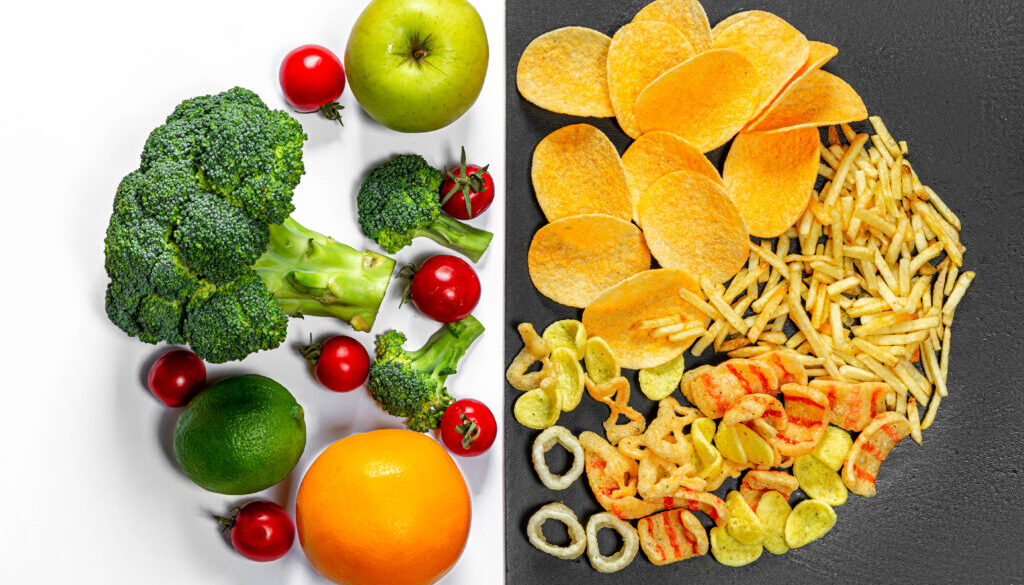In debate over new “healthy” food labeling rules, researchers propose novel metric to guide consumers
The Food and Drug Administration (FDA) should redefine how it measures “healthy” food as it sets new rules governing the claims manufacturers make on product labels, a nonprofit research group asserts.
The Heartland Health Research Alliance (HHRA), an organization that studies the health effects of food and farming, recently submitted comments to the FDA calling on the agency to adopt a metric HHRA has developed that conveys a food’s healthiness in a single, color-coded number. This metric, called “NuCal,” aims to capture the relationship between a food’s essential nutrients and its caloric content, according to HHRA.
“There are a lot of people whose daily diet is grossly deficient in multiple essential nutrients despite the fact that they think they’re buying perfectly healthy food because a lot of it’s packaged as healthy for you,” said Charles Benbrook, an agricultural economist and policy expert who serves as executive director of HHRA. Benbrook said NuCal could help consumers make purchasing choices that lower their risk for obesity, diabetes, and other diseases.
The scoring system focuses on the essential nutrition value found in individual foods rather than food groups.
“What we wanted to do was to try to lay out… a system that has a much greater chance of delivering to consumers [a clear and compelling] message about what’s healthier and what’s not,” he said.
The HHRA proposal comes in response to a plan by the FDA to revise the rules that define food products that can be labeled as “healthy.” Products labeled “healthy” would need to meet certain food group benchmarks recommended by the Dietary Guidelines for Americans. Food products would also need to follow limits for saturated fat, sodium, and added sugars.
If the FDA’s proposed definition is adopted, water, avocados, nuts and seeds, certain oils, and fatty fish such as salmon would qualify for labels bearing the “healthy” claim. White bread and highly sweetened yogurts and cereals, which qualify as “healthy” now, no longer would.
The FDA says it will thoroughly review comments before announcing a finalized definition.
Color coding for consumers
Under the HHRA proposal, determining a NuCal value for a serving of food would start with a scientist in a laboratory measuring the essential nutrients in that food. Using an orange as an example, the scientist would start by peeling the orange, grinding it up, and then testing the mixture for essential vitamins. The scientist would then determine how much of the recommended dietary allowance the orange provided for each essential nutrient, then add up all the values to determine the degree to which the fruit meets daily nutrient needs. The final score is achieved when the scientist divides that number by the proportion of calories the orange takes up in a recommended daily diet.
NuCal numbers would be fitted to a color-coded scale, falling into green (healthy), yellow (mid-range) or red (not healthy) categories. Ideally, Benbrook said, the government would require the NuCal metric on all foods, suggesting it could be part of the Nutrition Facts label. The scores could also be useful on websites offering customized food-as-medicine advice for pregnant women or people suffering from a range of medical conditions, said Benbrook.
“Once consumers understand the basic concept behind the NuCal metric, they will understand that the higher the number, the farther into the green, the better, and don’t include too many red zone foods into your daily diet,” said Benbrook. “It is entirely possible for the government to educate the American public to understand this concept.”
Broad debate
The FDA’s proposed rule changes have drawn more than 1,500 comments from researchers, trade associations, and advocacy groups from across the country.
The action is “part of the FDA’s ongoing commitment to improving nutrition and dietary patterns to help reduce the burden of chronic disease and advance health equity,” said an FDA spokesperson. “More than 80% of people in the US do not eat the recommended amounts of fruits, vegetables, dairy and whole grains. The proposed changes to the definition reflect the importance of these food groups in creating healthful dietary patterns.”
Still, the FDA said its proposed update would only help 0 to 0.4% of people who already try to follow current dietary guidelines make meaningful changes to the foods they purchase.
“One problem with the FDA proposed definition is that the standards are set so high that practically nothing passes,” said Adam Drewnowski, a researcher who studies obesity and social disparities in diet and health at the University of Washington.
The changes have sparked debate between food industry players and consumer organizations.
In comments it filed with the FDA, the American Beverage Association asked the agency to recognize that beverages, in addition to water and flavored water, can qualify as “healthy.” It also called on the agency to reconsider a proposed limit on added sugar so that dairy alternatives other than soy beverages can earn the label.
The Sugar Association, which represents US sugar beet and sugar cane farmers, processors, and refiners, stressed in its comments that the FDA should not set new added sugar limits without “analyzing the food supply with consideration of the functional roles of added sugars in foods.” The association states in its comments to the agency that many foods containing added sugars deliver important nutrients.
In contrast, the Union of Concerned Scientists urged the FDA to introduce conditions limiting calories from added sugar to no more than 10% of the total calories in a food labeled “healthy.”
The Council for Responsible Nutrition — the trade association for the dietary supplement and functional food industry — weighed in as well, stating: “Although FDA’s food groups-based approach is reasonable and reflects [Dietary Guidelines for Americans] principles, it limits the types of products that could contribute to helping Americans make dietary changes.”
The National Consumers League (NCL), a nonprofit advocacy group, applauded the FDA’s food group approach. However, it also expressed concern that FDA is not adequately addressing criteria for certain nutrients.
“The Dietary Guidelines 2020-2025 continues to list five nutrients as posing a health concern due to low intake – calcium, vitamin D, iron, potassium, and fiber – and cites protein as an important nutrient for a healthy diet,” NCL stated in its comments submitted to the agency. “Accordingly, NCL joins with other consumer and public health organizations in urging that nutrient criteria include at least 10 percent of the daily value (DV) for these six beneficial nutrients.”
Let numbers “speak for themselves”
HHRA is not the first to try to score foods based on their nutrient content. In 2005, Drewnowski published a study that proposed a score called Naturally Nutrient Rich (NNR). Like NuCal, it operates based on nutrient density-to-calorie metrics. NNR has had little to no impact, said Drewnowski.
“In 18 years, it has not changed anything,” he said.
Benbrook sees what he says are important differences between NuCal and NNR. Drewnowski’s system calculates index scores based on 2,000 calories of a particular food — a tactic that produces nutrient density ratios independent of serving size. In contrast, NuCal calculates scores based on the serving sizes listed on Nutrition Facts panels.
“The NuCal metric really places into accurate perspective the nutritional contribution of a serving of one food compared to others, taking into account the caloric density of one serving of each food,” said Benbrook. “This is the most important conceptual innovation in NuCal that I believe makes it a uniquely promising alternative for the FDA to consider, as well as other countries around the world working on similar systems and food companies that want to manufacture and promote truly more healthy products.”
“Obviously there will never be a system that does it all, that works for all people and all diet-health fissures, but a system like NuCal could do a lot of good if the government would just let the numbers speak for themselves,” said Benbrook.
When The New Lede asked the FDA if it is considering implementing a single-metric system like NuCal, a spokesperson responded: “FDA will be conducting research toward the development of a standardized [front-of-package] labeling system for food packages to help consumers, particularly those with lower nutrition literacy, quickly and easily identify foods that are part of a healthy eating pattern.”
(Featured image: “Lifestyle choice concept”. Photo by Marco Verch Professional Photographer. Licensed under CC BY 2.0)




